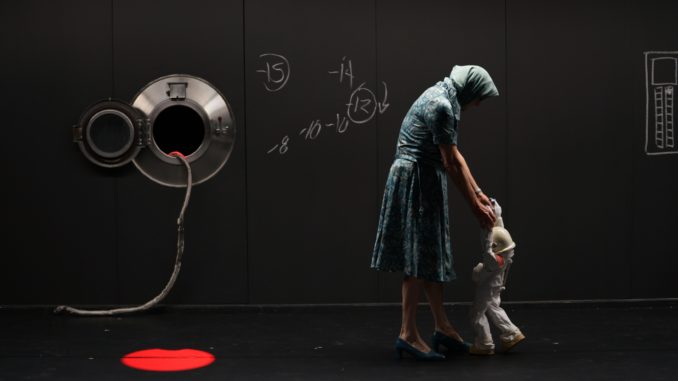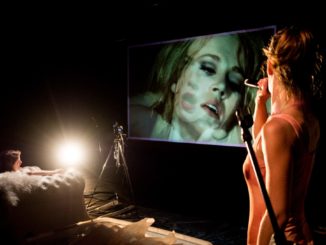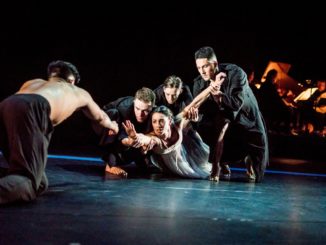
[Looking Beyond the Mirror]
On 17th of July, 1975, over a billion people tuned into their televisions to watch two men shake hands. Russian cosmonaut Alexey Leonov reached through the hatch of the Soyuz into the vacuum of Space to shake hands with American astronaut Brigadier General Thomas Stafford. While the rivalry between the two nations’ space programmes had spurred the space race, this was a gesture towards a new cooperation. Stafford commented: “When we opened this hatch in space, we were opening, back on Earth a new era in the history of man.”
This is one of the historical moments illuminated in Robert Lepage’s The Far Side of the Moon. The title refers to the side of moon we can’t see from Earth, the dark other hidden from our gaze. It wasn’t until 1959 that its pockmarked surface was first documented by the Soviets, who named many of the features of its terrain; in 1968 the Apollo 8 crew became the first people to view the far side with their own eyes. The two sides of the moon loom as a central motif of this work: the far side the Russians found first, the near side the Americans landed on. Far Side is obsessed with duality and binary oppositions. Even the nuance of astronaut versus cosmonaut is expanded on: sailors seeking the stars versus sailors seeking the cosmos.
Far Side continually presents us with such mirror images: a thesis and antithesis struggling to synthesise, dark doubles struggling to shake hands. We’re told that people used to believe the moon acted as a giant mirror, reflecting back a distorted image of the earth’s surface. The first image of Far Side is our own, the watching audience reflected back on ourselves via Far Side’s magnificent, giant rectangular mirror, which stretches to the wings of the stage. It seems to ask of us what reflection of our own lives we will see within the work, ego-voyeurs seeking resonance with our own circumstances. The mirror can rotate, harsh light blinding our eyes as it turns, a brief moment of discomfort. On the other side of the mirror? A blankness, a ready canvas for some awe-inspiring theatrical illusion.
The mirror is a signature visual flourish by Canadian writer and director Robert Lepage, for whom the term visionary, for once, is an apt descriptor. His company, Ex Machina has been an infrequent visitor to New Zealand during Festival times. Wellington most recently hosted Needles and Opium (2014) and The Far Side of the Moon made an earlier voyage there way back in 2002. Aucklanders might remember Lepage’s The Andersen Project in 2009. Lepage’s work is known for its innovative integration of multimedia, stunning theatrical transformations, and enigmatic storytelling. The Far Side of the Moon features incredible spatial design, digital wizardry, archival footage of humanity’s space feats, a looping musical score by Laurie Anderson that gets under your skin, puppetry, chalk, and a solo actor.
The actor is long time Lepage collaborator Yves Jacques (who also performed in The Andersen Project’s Auckland tour). While Lepage originally performed in the work (which debuted in 2000), Jacques was an early alternative and has been performing the show for years. His characterisations are deep, well-worn, and snug.
Jacques plays two estranged brothers (you’ve noted the pattern, right?) who are propelled back into each other’s spheres following the death of their mother. The eldest, Philippe, is a wannabe academic and cultural theorist having troubles passing the oral defense of his Doctorate. His thesis argues that humanity’s quest to voyage into space was driven primarily by narcissism (linking with the moon as mirror). He examines the work of Konstantin Tsiolkovsky, who proposed the concept of a “Celestial Castle” – a towering space elevator to reach into Space. The youngest brother, André, is a successful TV weatherman, who the introverted Philippe finds overbearing. Philippe gazes outward at the universe; André gazes earthward with the weather maps.
When Jacques first performed in Far Side he was close to the character’s ages (early 40s). Now in his early 60s, the incongruity of Jacques’ age adds a further melancholy quality to Philippe as the character grapples with mortality and stasis. While he’s interested in the big questions – ‘Are we alone?’, ‘Is there life out there somewhere?’ – he’s living a life of isolation on earth in his shoe box apartment, traversing the plains of loss and loneliness. He adopts his mother’s goldfish, which Philippe sees as a mirror of himself. While doing the ironing, he sees an information about the SETI (Search for Extra-Terrestrial Life) programme. He begins filming himself and his life, hoping his tapes will be selected to be beamed into space. Constriction, and expansion.
Mundanity and profundity become an important mirror image, increasingly collapsing in on each other. A laundromat door becomes a space shuttle hatch. Extended scenes grounded in the drudgery of the everyday explode into transcendent flights of theatrical fancy. Great space conquering achievements sit against tiny lives.
Far Side is a show that both rewards close attention and allows you to let the experience wash over you. Its construction is remarkable, and you can tease out the connections and ponder its depths long after leaving the theatre. But I also found myself floating away at times, gazing up at the architecture of the Aotea Centre’s ASB Theatre and the distorted shapes created by the stage lighting. Sitting in a kind of goldfish bowl, watching another goldfish bowl, containing a digital projection of a goldfish bowl, the work put me in the frame to ponder the contradictions and cosmic comedy of our existence.
It’s absurd, isn’t it? 7.3 billion people on this globe and we’ve gathered in the theatre to concentrate on just one person pretending to be someone they are not.
But through this person, and this artistry, we can contemplate the mysteries of the infinite and the beauty of the everyday; the wonders of the cosmos and the unknowable in ourselves.
18 years from its debut, The Far Side of the Moon is still pushing the frontiers of what theatre can do, the places theatre can take us, and the meanings that we can find.
Theatre like this only appears once in a blue moon: do not let it pass you by.
The Far Side of the Moon is presented by Ex Machina and the Auckland Arts Festival and plays at the ASB Theatre, Aotea Centre until 25 March.




Leave a Reply